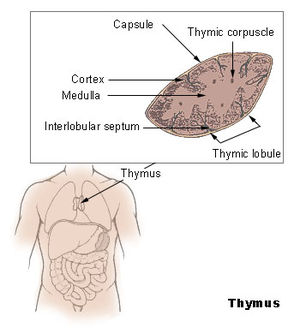Immunological tolerance and the possibilities of its induction
Immunological tolerance is a state where the organism does not respond to an antigenic stimulus. Immunological tolerance can be specific or non-specific.
- Non-specific: the immune system is inactivated and does not react against any antigens (including bacteria and viruses). It can be induced, for example, by radiation or cytostatics, the effect of which disables immunocompetent cells from functioning and induces immunosuppression.
- Specific: the organism does not respond only to the antigen that was used to induce tolerance, but normally responds to other antigens
In physiological situations, tolerance is induced against the body's own components (self tolerance), thereby protecting it from immune attack.
Tolerance of the organism's own components[edit | edit source]
The response of effector T and B-lymphocytes is dependent on T cells. Mechanisms of inducing T cell unresponsiveness: they take place during the development of T cells from their precursors in the thymus, there are rearrangements of genes for T cell receptors, which then appear on the cell surface. T cells are then subjected to two types of selection:
- negative selection: clones with high affinity to own molecules I. or II. classes with self-antigens perish;
- positive selection: clones that have very low or no affinity for the complex of own HHK molecules and own antigen also die.
The result of selection is clonal deletion and survival of clones with low affinity for own HHK molecules with a peptide fragment. They mature into CD4+ or CD8+ T cells.
Receptors of T lymphocytes react in the thymus with cells that present their own antigens – peptide fragments of cellular proteins – with the help of HHK molecules. Antigens that have not been presented in the thymus can also be tolerated because:
- they are in so-called immunologically privileged places – due to the anatomical barrier, these antigens are inaccessible to lymphocytes (e.g. antigens of spermatozoa in the testes, eye lens, etc.),
- they encounter cells that cannot present antigen because they do not express HHK molecules,
- they are present in small amounts and are therefore not detected by T-lymphocytes,
- insufficient contact of the TCR and accessory molecules with the antigen.
Induced tolerance to foreign antigens[edit | edit source]
- In an experiment, tolerance can also be induced to antigens of allogeneic origin – after inoculation of allogeneic cells or tissue transplantation into a newborn organism that does not react because it does not have a mature immune system.
- Tolerance can also be induced in an adult host whose immune system has been suppressed - by radiation, drugs, using lymphocyte antibodies, etc.
- In adult animals, tolerance can be induced even without suppressing the immune system - it depends on the dose, the method of administration and the nature of the antigen - low and high doses of the antigen usually induce tolerance, medium doses immunity; very high doses of antigen can cause exhaustion of the immune system (clonal exhaustion) - it is caused by the stimulation of all cells capable of responding, no memory cells are formed - the organism does not respond to repeated antigen supply.
Links[edit | edit source]
Related articles[edit | edit source]
References[edit | edit source]
- ŠTEFÁNEK, Jiří. Medicína, nemoci, studium na 1. LF UK [online]. [cit. 11. 2. 2010]. <http://www.stefajir.cz>.

